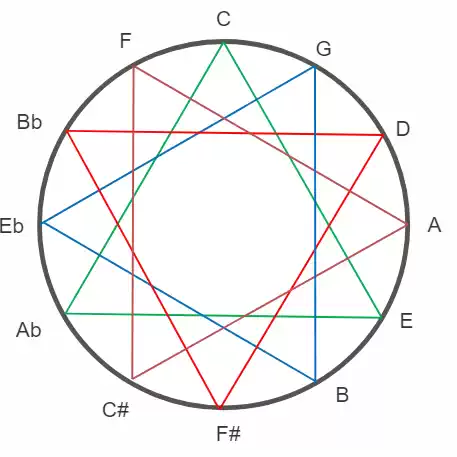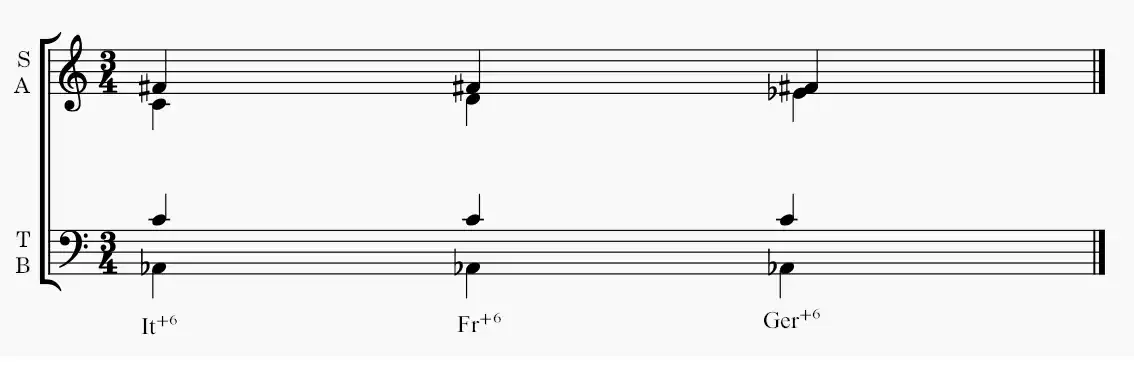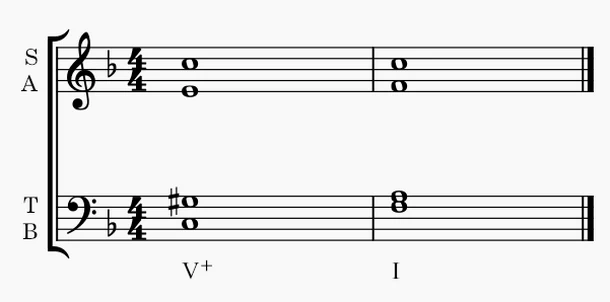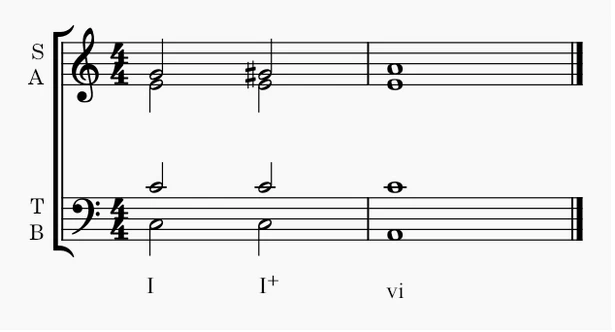Do you know that the film music during all the dream sequences contains augmented chords? The augmented chords have a mysterious sound and can suspend the tonality. This does not in any way preclude its usage in tonal music. In fact, it has a chunkier sound than the V chord and can easily replace it.
In this article, you can familiarize yourself with the augmented chords, including the related music theory, chord spellings, types, their use in classical music, voice leading, resolution, etc.
Read the complete article to know this and more!
What is an Augmented Chord
As explained in our article on the basic triads, you can have four types of triads in music theory using the tertian harmony – the major, minor, diminished and augmented triads.
An augmented triad has two major thirds stacked on top of the root note. Hence, its intervals are R – M3 – M3. If you compare it to a major triad, the interval between the 3rd and the 5th is a major third instead of a minor third.
For example, the notes of the C augmented triad or C+ are [C E G#]. It has a G# instead of the G in the C major triad, which has notes [C E G].
Augmented Music Theory
As you can see, the last note is at an interval of augmented 5th from the root. This interval is enharmonically equivalent to a minor 6th interval, eight semitones above the root.
You can also form the major triad by raising the fifth by a half step from the P5 to an augmented fifth interval, as seen in the example above. There, G in the C major chord was raised to G# to form the Caug triad.
Hence, the chord formula for the augmented triads is [1 3 #5] in terms of notes of the major scales or [0, 4, 8] semitones from the root.
The augmented chords fall into the category of symmetrical chords, as the intervals between their notes are the same. A diminished chord (triad) and a fully diminished 7th chords are also symmetrical chords.
How to write an augmented chord
The Augmented triads are represented by either the “aug” or a “+” symbol after the first note, like, Caug or C+.
Augmented Triads
As you know, you get only major, minor, and diminished chords by harmonizing a minor or major scale. Hence, augmented chords are not naturally occurring in any diatonic scale.
You can get an augmented triad from the harmonic minor scale or the melodic minor scale. Consider the C Harmonic minor scale with the notes [C D Eb F G Ab B], the chord formed by the chord root at scale degree 3 [Eb G B] is an augmented triad. It is represented as the III+ chord.
Minor keys are a bit complicated as all three minor scales (natural, harmonic, and melodic) are used by composers in different situations. III chord is commonly derived from the natural minor as a major chord.
Augmented triads can be formed by raising the 5th note of the III chord in a minor key or the I, IV, and V chord in a major key by one semitone. But these chords are not in their key.
The spelling of an Augmented Triad
You can obtain the notes of the augmented triads from the representation of the circle of fifths below. The concept uses the symmetry of intervals, which we spoke about above. Each note of the circle is connected to a note at a gap of three notes from its position in both directions. There are 4 such combinations of 3 notes represented in different colors.

The other two notes in the same combination in the clockwise direction represent the notes of that chord. Consider the green combination with notes C, E, and Ab.
The notes of the C augmented triad in a green color equilateral triangle are [C, E, Ab]. Similarly, the notes of E augmented and Ab augmented triads are [E, Ab, C] and [Ab C E], respectively.
The red combination has notes D, F#, and Bb/A#. Hence,
D Augmented triad: [D, F#, A#]
F#+: [F#, A#, D], and
A#+: [A#, D, F#].
There are four such combinations only shown in different colors in the circle above.
Augmented 7th Chords
The augmented seventh chords have two variants, derived from the Major 7th chords or the dominant 7th chords. The Maj 7th variant is formed from the first and the fourth degree of a major scale, while the dominant 7th variant results from the fifth degree. Each of these two variants has a different chord structure, as discussed below.
Major 7th Variation or the Major7(#5) Chord
This variation is formed from the augmented triads by adding a minor third interval over the two major third intervals.
Consider the CMaj7 chord in the C major scale with the notes [C E G B] or the chord formula [1 3 5 7]. If we raise the 5th note by a semitone, we get the notes [C E G# B] and the revised chord formula [1 3 5# 7]. Raising the 5th reduces the interval between the 5th and the 7th note to a minor 3rd.
Dominant 7th variation Or The Dominant 7(#5) Chord
This variation of the augmented seventh chords has a diminished 3rd interval over the augmented triad instead of a minor 3rd.
Consider the 7th dominant chord in the key of C, the G7 with the notes [G B D F], or the chord formula [1 3 5 b7]. Raising the 5th results in [G B D# F] and the chord formula [1 3 #5 b7].
This chord has both augmented and diminished intervals in its structure between (1 & #5) and (#5 and b7), respectively. The diminished third interval is the same as the major second.
These variations can substitute a major or a dominant chord in a chord progression.
Augmented 6th Chords
In classical music, an augmented sixth chord comes in three varieties – Italian, French, and German. Each of these has a minor variation, depending on the type of music prevalent in these countries, which is discussed while spelling the chords below.
The spelling of an Augmented 6th Chord
You need to carry out the following steps to spell these chords.
- Select your scale and the scale degree you want to build your Aug6 chords on, except the ones on which you usually build diminished chords. Let us select a C major and scale degree 5, the G, for this discussion.
- The bass note of the Aug6 chord will be an m2 interval or a semitone above the selected scale degree, i.e., Ab in the present case.
- The top voice will be an m2 interval below the G(O), i.e., F#. Note that G(O) is one octave higher than G. Note that there is an interval of Aug 6th between Ab and F#, which is enharmonically similar to an m7 interval.
- Add M3 to the bass note to get another upper voice, i.e., a C. The three notes [Ab C F#] form the core of the augmented 6th chord.
- This is where the three types, the Italic, French, and German versions, come into play.
- The Italic version is designated as IT+6. In four-part writing, it doubles the M3 note above the bass. You have Ab, C, C, and F# voices, as shown in the grand staff diagram below. In three-part writing, only the core is used.
- The French version is designated as Fr+6. Add a note at an A4 interval above the bass. You now have Ab, C, D, and F# voices, as shown in the grand staff diagram below.
- The German version is designated as Ger+6. Add a note at a P5 interval above the bass. You now have Ab, C, Eb, and F# voices, as shown in the grand staff diagram below.
These chords are designated IT+6/~5, where ~5 is the scale degree on which the chord is built.

Dissonance in The Augmented Chords.
All the augmented chords have a dissonant sound. While the simple frequency ratios and the consonant intervals are important requirements for chords to produce a consonant sound. The other factor that comes into play here is that dividing an octave into a large number of smaller equal intervals or a smaller number of large but equal intervals also results in dissonance.
An augmented triad divides the octave into three equal parts with M3 intervals. Similarly, a fully diminished 7th chord divides it into four equal parts with m3 intervals. Such chords are dissonant in nature.
In addition, any 7th chord is dissonant, as all 7th intervals between their root and the 7th are dissonant.
Inversion of the Augmented Chords
The inversions of the augmented chords are different than any major and minor triads. Let us see why.
Consider the C+ triad with its root position [C E G#]. Its first inversion will be C+/E made up of [E G# C], and the second inversion is C+/G# comprising of [G# C E].
Now let us take an E+ chord with notes [E G# B#]. As you are aware, B# is enharmonically equivalent to C. Hence, the E+ chord is the same as the C+/E chord. Theoretically, the intervals in C+/E are a Major 3rd (M3) and a diminished 4th (D4), which are again enharmonically equivalent.
Similarly, the intervals of the 2nd inversion C+/G# are D4 and M3, equivalent again to two M3 intervals enharmonically. G#+ is enharmonically equivalent to Ab+ with notes [Ab C E], and hence having the same notes as C+/G#.
The takeaway from the whole discussion is that it is not feasible to identify from the given notes whether they are an inversion of any augmented chord or an augmented chord itself due to the symmetry of the pitches.
The inversions of the augmented 7th chords and augmented 6th chords are dealt with in separate articles on these topics.
Voice Leading in the Augmented Chords.
The resolution of the augmented triads happens by:
- The bass voice descends by five degrees, ascends four degrees, or remains stationary.
- The third either ascends a minor second (half step) or maintains the same position.
- The fifth ascends a minor second.
You can see the resolution of the F+ triad to I chord in the diagram below in the key of F major.

As you can see, the root C moves up by four degrees to F, the third E moves to F by a minor second, and the fifth G# moves to A by a minor second. The doubled root is stationary.
In the voice leading from I to I+ (on the way to either of ii, IV, vi), three voices are stationary, and one voice changes by a minor second. In the below diagram in C major, only G moves to G#. From I+ to vi, the inner voices are stationary, and outer voices move in contrary motion. Soprano moves up from G to G# to A in stepwise motion, while C in bass descends to A.

How to use augmented chords?
The augmented chords have the ability to produce a mysterious, dreamy kind of sound often associated with otherworldliness and unease. They find their usage in classical music, fusion, rock, and jazz music. They are used to carry out the dominant function as a passing chord, replace the dominant chords in modulations and add flavor. Let us discuss each of these functions.
As substitutes for the Dominant Chords
You can substitute the dominant V chords with the augmented V+ chords. The augmented chord sounds chunkier than the dominant chord and increases the tension and dissonance. You can use 7#5 chords if you want to use the seventh chords. Both V+ and V7#5 resolve to the I chord.
Some of the examples in popular music where augmented chords have been used are
- “Oh Darling” by the Beatles used the progression (E+ – A – E – F#m) in the key of A.
- The Beatles used augmented chords extensively in their songs. The song “From Me to You” used G – G+ – C.
- Chuck Berry, in his song “School Days,” used D+ to G.
- “Mama Mia” by ABBA used D – D+ repeatedly.
Use as a Passing Chord.
To understand the concept, let us consider the example of the C+ triad [C E G#]. G# is enharmonically equivalent to Ab. Let us lower each of the notes of the triad by a half step.
- By lowering C to B, we get [B E G#], which is E major in the second inversion.
- Lowering E to D# results in [C D# G#], which is the enharmonic equivalent of [B# D# G#]. This is G#6 major chord.
- Lowering G# to G, we get [C E G]. This is C major chord.
Similarly, if we raise the notes by a semitone, we get:
- Raising C to C# gives [C# E G#] = C# minor chord.
- Raising E to F gives [C F G#], enharmonically equivalent to [C F Ab] = Fm6/4 minor chord.
- Raising G# to A gives [C E A] = Am6 chord.
Hence, (C, Am), (E, C#m), and (Ab, Fm) are linked to the C+ chord by a half step. So C+ can act as a passing chord with step movement in approach and resolution between these chords.
For example, C – C+ – Fm – G7 – C, or E – C+ – C#m
Augmented Chords In Other Progressions
The G# has a natural movement to A as its leading tone. A is also in the key of C and the root of the vi chord. Similarly, the IV chord (F major) and ii (Dm) also have A as their tone. Hence the augmented chords can be easily used in the following progressions if you take care of the voice leading.
- I – I+ – vi.
- I – I+ – IV.
- I – I+ – ii – (V or V7) – I.
In the progression C – C+ – Db – G7 – C, Db is the Neapolitan chord.
Modulation Using the Augmented Chords
You can modulate to other keys by either using the secondary dominants of the augmented chords.
Another method is to use the symmetry of an augmented chord, whereby the inversions result in other augmented chords. Let us consider C+ triad. E+ is an inversion of the C+ triad and a separate chord.
Consider Am as the old key and Fm as the new key. You can use the following progression to modulate.
Am – Dm – E+ – Am – Dm – E+ (C+) – Fm – Gm – C+ – Fm – Gm – C+.
and i – iv – V progression in the key of A is A – Dm – E
Conclusion
Now that you know all the basics about the augmented chords, practice and try to use them in your music. If you have any doubts to clarify or comments on the article, feel free to use the comments section below.
